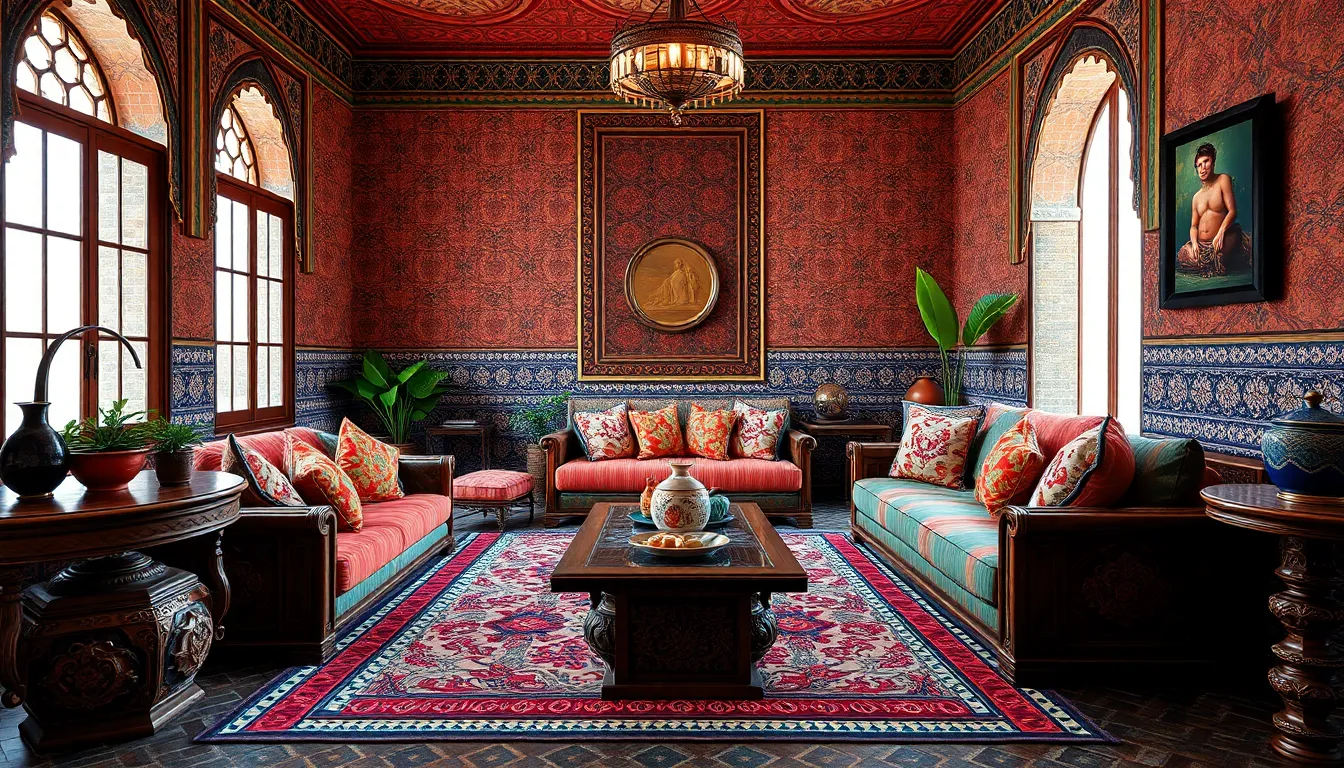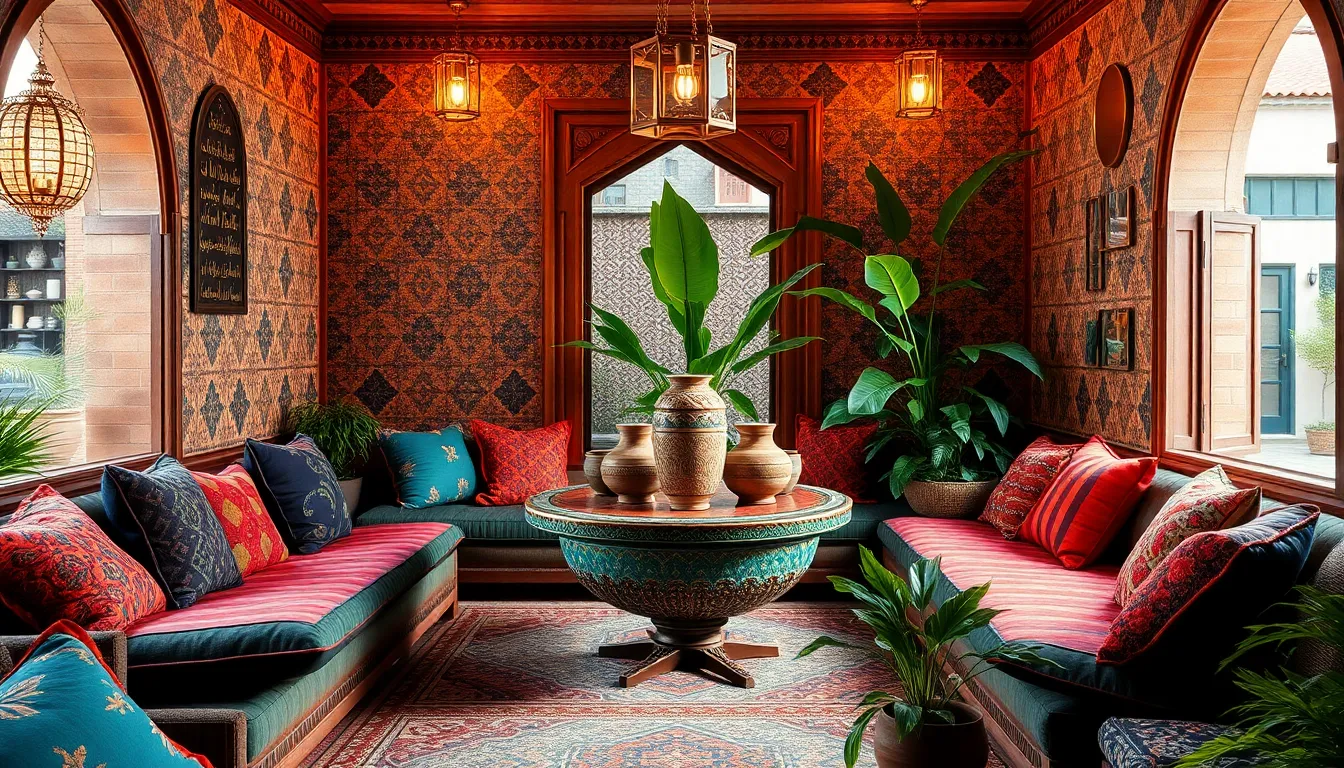Moroccan style is like a colorful spice market for your home, bursting with vibrant patterns and rich textures that transport you straight to the heart of Marrakech. Imagine lounging on plush cushions surrounded by intricate lanterns that cast playful shadows, all while sipping mint tea as if you’re royalty. This isn’t just decor; it’s an invitation to embrace a lifestyle that celebrates warmth, hospitality, and a dash of exotic flair.
Table of Contents
ToggleOverview of Moroccan Style
Moroccan style embodies a rich tapestry of colors, patterns, and textures that create a warm and inviting atmosphere. Derived from a blend of Berber, Arab, and French influences, it showcases intricate tile work, vibrant textiles, and ornate furnishings. This decor often features bold colors like deep reds, vibrant blues, and bright yellows that evoke the essence of a lively souk.
Furniture plays a pivotal role in establishing the Moroccan aesthetic. Low seating arrangements, plush cushions, and wooden screens invite relaxation and conversation. Glamorous lanterns and intricately designed lamps set the mood, casting soft shadows and adding to the exotic ambiance.
Artistic elements enhance the unique character of Moroccan style. Handcrafted pottery, woven rugs, and vivid artwork celebrate local craftsmanship. Wall decorations often include mosaic tiles and Arabic calligraphy that narrate cultural stories, further enriching the decor.
Natural materials contribute to the authenticity of Moroccan style. Wood and metal accents provide a rustic feel, while colorful textiles deliver comfort and warmth. Incorporating indoor plants can enhance the inviting nature of the space, bringing a touch of greenery into the mix.
Lighting remains crucial in Moroccan decor. Warm, soft lighting creates an intimate environment, encouraging relaxation and enjoyment of the space. Statement pieces, such as hanging lanterns and chandeliers, serve as focal points that draw the eye and elevate the overall decor.
Embracing Moroccan style involves a seamless blend of comfort, artistry, and vibrant colors. The overall effect inspires a sense of tranquility while celebrating a rich cultural heritage. This style creates not just a home but a sanctuary filled with life and personality.
Key Elements of Moroccan Style

Moroccan style features distinctive elements that contribute to its charm and vibrancy. Combining various cultural influences, this aesthetic creates a unique ambiance.
Color Palette
Rich jewel tones dominate the Moroccan color palette. Colors like deep blues, vibrant reds, and lush greens bring warmth and life into spaces. Bright yellows and earthy browns complement these hues, adding depth and variety. Combining these colors in textiles, wall art, and decorative accessories creates an inviting atmosphere. Additionally, the inclusion of metallics like gold and silver adds a touch of glamor, capturing the eye and enhancing overall elegance.
Textures and Materials
Textures play a crucial role in Moroccan decor. Luxurious fabrics such as silk, velvet, and wool contribute softness and warmth. Intricate tilework, often seen in geometric patterns, adds visual interest and character to floors and walls. Hand-carved wood furnishings showcase artisanal craftsmanship and create focal points in rooms. Natural materials like clay and stone enhance authenticity, grounding the design in cultural heritage. Combining these various textures fosters a layered look that embodies the spirit of relaxation and comfort.
Furniture in Moroccan Style
Moroccan furniture combines artistry and function, reflecting a rich cultural history through various designs.
Traditional Pieces
Traditional Moroccan furniture includes low tables, known as “zellige,” often adorned with intricate tile work. These tables enhance social gatherings, inviting people to sit comfortably on plush floor cushions. Carved wooden stools and benches add character, showcasing skilled craftsmanship. Brass and wrought iron lanterns bring warmth and ambiance, with their complex patterns casting mesmerizing shadows. Sturdy chests, often heavily embellished, serve as both storage and decorative elements, reinforcing the eclectic style.
Modern Interpretations
Modern interpretations of Moroccan furniture blend traditional aesthetics with contemporary design. Designers often use sleek silhouettes and minimalist approaches, infusing bold colors and rich textures. A stylish coffee table might feature a geometric pattern, echoing classic motifs while remaining functional in today’s homes. Fabrics like velvet and linen frequently appear in modern pieces, retaining comfort and elegance. Moroccan poufs have gained popularity, combining vibrant leather with versatile usage, perfect for adding a splash of color to any room.
Decor and Accessories
Moroccan style thrives on the vibrancy of decor and accessories, creating a captivating atmosphere. Key components enhance the aesthetic, making any space inviting and warm.
Lighting
Lighting plays a vital role in Moroccan decor. Brass and wrought iron lanterns cast mesmerizing patterns across walls, while colorful glass fixtures add a whimsical touch. Intricate designs celebrate craftsmanship, whether in a traditional or modern setting. Statement chandeliers often draw the eye, emphasizing the room’s height and grandeur. Dim lighting enhances relaxation and establishes a cozy ambiance, perfect for evening gatherings.
Rugs and Textiles
Rugs and textiles serve as essential elements in Moroccan style. Richly patterned area rugs anchor spaces, offering both comfort and style. Materials like wool or cotton reflect quality and durability, contributing to the overall warmth. Luxurious fabrics, including silk and velvet, add layers and textures, inviting touch and interaction. Additionally, colorful cushions and throws highlight jewel tones, enhancing both visual appeal and comfort. Each piece narrates a story, connecting modern living with Morocco’s rich heritage.
Incorporating Moroccan Style in Your Home
Incorporating Moroccan style into your home creates a vibrant, inviting atmosphere filled with rich colors and textures. This unique aesthetic seamlessly combines bold patterns with cultural elements, resulting in a warm and hospitable environment.
Tips for Beginners
Start with a rich color palette focused on jewel tones, such as deep blues and vibrant reds. Include metallics for added glamor and warmth. Layer textures by incorporating various fabrics, like silk and velvet, alongside intricate tilework. Introduce low seating arrangements to reflect Moroccan traditions. Accessorize with handcrafted pottery and textiles to celebrate local craftsmanship. Use lighting fixtures, such as lanterns and chandeliers, to create an enchanting ambiance. Integrate greenery through indoor plants to enhance authenticity and warmth.
Avoiding Common Mistakes
Avoid overwhelming spaces with excessive decoration, which can detract from the overall aesthetic. Steer clear of mixing too many styles that may clash with Moroccan influences. Keep color combinations cohesive by sticking to the established jewel tones and earthy hues. Do not overlook the importance of balance; ensure that larger furniture pieces are complemented by smaller accents. Refrain from ignoring functional elements like seating, as comfort remains essential. Focus on showcasing quality craftsmanship through selected pieces rather than quantity. Creating a harmonious blend while incorporating Moroccan style makes the space inviting and uniquely yours.
Moroccan style offers a unique blend of comfort and artistry that transforms any space into a vibrant sanctuary. Its rich colors and intricate textures invite warmth and hospitality, making homes feel welcoming and alive. By incorporating key elements such as low seating arrangements and handcrafted decor, individuals can create an inviting atmosphere that reflects the essence of Moroccan culture.
Embracing this aesthetic not only enhances the visual appeal of a home but also fosters a sense of tranquility and connection to a rich heritage. With thoughtful choices in decor and a focus on quality craftsmanship, anyone can achieve the enchanting allure of Moroccan style in their living spaces.




